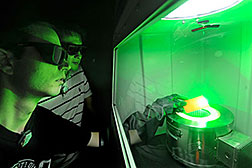- Number 402 |
- December 2, 2013
Idaho laser research could benefit nuclear fuel recycling

The high-power laser within the Center for
Advanced Energy Studies at INL.
James Bond used a laser beam to cut through windows and walls, but scientists with the Center for Advanced Energy Studies (CAES) at DOE's Idaho National Laboratory are using a new laser that can melt metal.
Scientists are evaluating a system called Laser-Induced Breakdown Spectroscopy (LIBS), which uses a high-power laser to discern the contents of used nuclear fuel.
LIBS could provide real-time analysis of used nuclear fuel during recycling, a capability useful for both industry and government agencies. Knowing the element ratios throughout the recycling procedure can also prevent plutonium diversion for illicit use.
The laser's heat converts a speck of molten salt into plasma. As it cools, the elements inside the plasma emit photons. Different isotopes from elements give off characteristic photons at different wavelengths, which are collected by a spectrograph and a detector.
The wavelengths and intensity of the light collected can reveal the contents of the fuel, enabling precise calculations of how much plutonium or uranium is in the sample. Such information can help optimize processes and aid nuclear proliferation inspectors.
Supathorn Phongikaroon, the project's principal investigator, is still working on nonirradiated samples to test how accurately LIBS can record ratios. Soon the researchers will use cerium and manganese to calibrate the LIBS system. Since cerium emits characteristic wavelengths in the same range as plutonium, it is a good nonradioactive surrogate for testing how LIBS will run with the real thing.[Nicole Stricker, 208.526.5955,
nicole.stricker@inl.gov]
